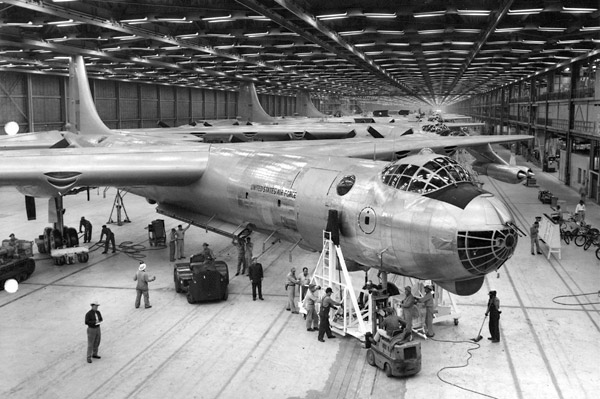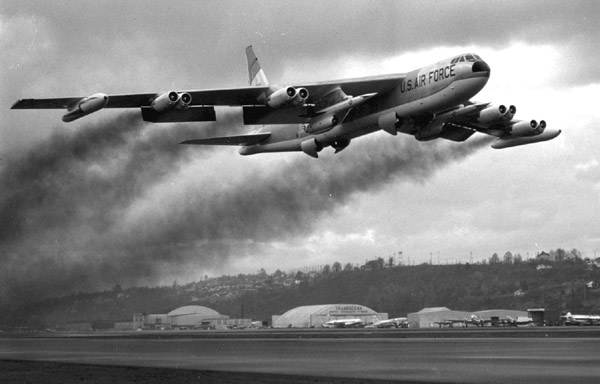STRATEGIC AIR COMMAND - Page 2
From its initial handful of wartime B-29 Superfortress bombers (only a few of which were "Silverplate" aircraft capable of dropping a nuclear weapon), SAC transitioned to its first, truly intercontinental bomber, the Convair B-36. Though a major improvement over the under powered B-29, the B-36, with its six piston and four jet engines, was slow to get to its target.

Boeing B-29 Superfortress USAF

B-36 Factory NMUSAF
The insignia of The Strategic Air Command was designed by Staff Sergeant R. T. Barnes, then assigned to the 92nd Bombardment Wing, in 1951. Submitted in a Command-wide contest, it was chosen as the winner by a three judge panel. The judges were: General Curtis E. LeMay, Commander-In-Chief, Strategic Air Command [CINCSAC]; General Thomas S. Power, Vice Commander-In-Chief, Strategic Air Command; and Brigadier General A. W. Kissner, Chief of Staff, Strategic Air Command. Staff Sergeant Barnes' winning design netted him a $100 United States Savings Bond.
SAC built up a substantial force of jet-propelled bombers. At its peak, the SAC force included more than 1,500 bombers, most of them the B-47 Stratojet.

B-47E JATO takeoff USAF

Boeing B-52F NMUSAF
When the first operational intercontinental ballistic missiles (ICBMs) became available in the late 1950s, they, too, were placed under SAC command. This led to a gradual decline in SAC's bomber strength.
Wartime experience in Europe had shown the inability of bombers to survive without fighter escort, so for a number of years SAC had a fighter force as well as bomber squadrons. Despite some USAF efforts to develop long-range escort fighters, the range of fighter aircraft was too limited for truly intercontinental range, and SAC philosophy held that interception of bombers was of limited value in the atomic age. As a result, on 1 July 1957 SAC's fighter squadrons were either disbanded or passed to TAC.
Curtis LeMay left SAC to become USAF Vice Chief of Staff in 1957, and was succeeded by General Thomas S. Power, who served as SAC commander until December 1964. He was followed by General John Dale Ryan (1964-1967) and General Bruce K. Holloway (1968-1972).
In 1992, following the collapse of the Soviet Union, and the end of the Cold War, SAC was eliminated in a reorganization of the major Air Force commands. SAC, TAC (Tactical Air Command), and MAC (Military Airlift Command) were reorganized into two commands, AMC (Air Mobility Command) and ACC (Air Combat Command). These two commands were essentially given the same missions that MAC and TAC held respectively, with AMC inheriting SAC's tanker force and ACC inheriting SAC's strategic bombers. The nuclear component was combined with the Navy's nuclear component to form USSTRATCOM (United States Strategic Command) which is headquartered at Offutt Air Force Base (SAC's former headquarters).
SOURCE: WIKIPEDIA